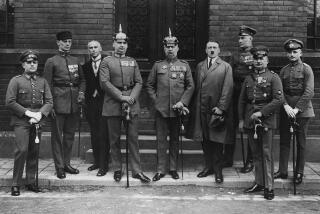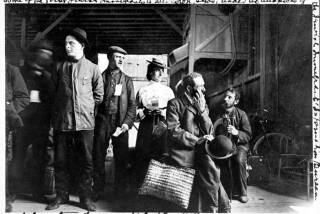Jew Who Escaped Nazis Sees Seeds of Freedom Sown : East Germany: A Corona del Mar professor who witnessed the rise of Hitler returns to his former home to find a new country in the making.
CORONA DEL MAR — As an 8-year-old Jewish boy in Hamburg, Max Wolfsberg saw Hitler. He and his family survived anxious moments during the frightful Kristallnacht in 1938, and they fled Germany the following year, a week before the Nazis launched their invasion of Poland.
Fifty-one years later, Wolfsberg--now a chemistry professor at UC Irvine--was back in Germany, and once again witnessed momentous events: the collapse of the Communist regime, the beginnings of democracy in East Germany and the dismantling of the Berlin Wall.
“It was overwhelming,” Wolfsberg said. “I’m completely convinced it’s irreversible.”
Wolfsberg had been invited to Leipzig for a month as part of an interacademy exchange administered by the National Academy of Sciences. He had been there before to attend conferences, had taught as a visiting professor at a West German university, and was well aware of the changes beginning to sweep through Eastern Europe.
But neither he nor his wife was prepared for the blistering pace of the political maelstrom they soon found themselves in.
They saw marches of half a million people in Leipzig. They attended a classical music concert that turned out to be fraught with political meaning. And, for the first time in their visits to the German Democratic Republic, the Wolfsbergs found strangers willing to talk to them--sometimes directly, sometimes in thinly veiled references to the historic events.
“We arrived in Leipzig around midnight Monday, Oct. 16,” Max Wolfsberg said in an interview after his return to Corona del Mar. “On Wednesday, people told us there was an earthquake in San Francisco--and that (East German leader Erich) Honecker resigned. There were two quakes that day.”
That evening, in the apartment given them for their month’s stay, the Wolfsbergs watched Egon Krenz, then the newly appointed government leader, deliver a 90-minute television address in which he promised to begin “a change of direction.”
The popular uprising that brought down Honecker had begun weeks earlier with weekly Monday marches in Leipzig, often right after a prayer service at the Nikolai Church in the old center of the city.
The Wolfsbergs agreed that they would watch the next demonstration on Oct. 23.
They joined a quarter of a million people who marched through Karl Marx Platz, past the city’s opera house and concert hall--and who stopped and booed in front of the headquarters of the hated Stasi, or security police.
“They would shout, ‘Visum frei bis Shanghai!’-- asking for unrestricted travel as far as Shanghai--or ‘Wir sind das Volk!’-- we are the people,” Wolfsberg said.
That slogan upset Wolfsberg because it was similar to one he heard as a boy in Nazi Germany: “Ein Volk, ein Reich, ein Fuehrer” --one people, one reich, one fuehrer.
“I was worried they would shout that also,” the white-haired theoretical chemist said, his carefully assembled collection of East German newspapers laid out before him. “It brought back the Nazi era.”
He recalled the day in 1936 when he demanded that his mother take him to see Adolf Hitler.
His class in the private school he attended was going downtown the next day to see Hitler’s motorcade, he explained.
“They suggested that I not go,” he said. “I made my mother take me. . . . I raised such a fuss.”
Because he was so small, his mother passed him forward to the front row of the crowd gathered to see Hitler. He ended up watching beside the knee of a Nazi storm trooper.
“I’m sure he didn’t know I was a Jew,” Wolfsberg said.
Soon enough, Wolfsberg said, he recognized “the terrible things” that were going on in his homeland. An uncle was put in a concentration camp. Nazis tried to arrest his father on Kristallnacht --”Night of the Broken Glass”--but were turned away. That night, on Nov. 9, 1938, Nazi mobs throughout Germany and Austria burned and pillaged Jewish homes and businesses.
Young Wolfsberg developed a case of jaundice soon after Kristallnacht. “It was stress-related,” he said he was told.
The Wolfsberg family fled Germany in 1939, flying to Sweden, then boarding a ship bound for New York. They lived in Galveston, Tex., for three years, before moving to St. Louis.
It was there, at Washington University, that Wolfsberg attended college and received his doctorate in chemistry. He came to UC Irvine in 1969.
Wolfsberg returned to Germany for the first time in 1959, while spending a year in Europe on a fellowship. He was still bitter about what his native country had done to him and his family.
“You were impossible,” Marilyn Wolfsberg recalled, shaking her head.
Other Visits
Still, Wolfsberg made other trips to Germany. In 1977, he was awarded a prize from the German Humboldt Foundation and was invited to work for a year at the Max Planck Institute in Mainz, West Germany.
He told the secretary general of the foundation that he was not sure that he should even accept the award.
“I poured out my feelings to him,” Wolfsberg said. “After that . . . I began to feel comfortable. . . . I don’t have those feelings anymore.”
And how did Wolfsberg, a survivor of the Nazis, feel during his most recent journey to East Germany--with the prospect of a united Germany once again dominating the map of Europe suddenly looming nearer than at any time since World War II?
“I’m not sure yet,” he said. “I can’t sort those feelings out.”
It was easy enough in Leipzig, however, for both Wolfsbergs to grasp the growing feelings of resentment and anger among East Germans toward a corrupt regime--and the excitement of a people speaking out for the first time in decades.
One night, the couple attended an all-Tchaikovsky concert by the famous Leipzig Gewandhaus Orchestra. The conductor, Kurt Masur, had been one of the earliest figures in Leipzig to speak out against the government, and he had recently returned from a tour of the Soviet Union.
When Masur came out to open the concert, the audience stood and applauded for 10 minutes.
“There were two party members in front of us, wearing party pins,” Max Wolfsberg recalled. “They didn’t applaud.”
While Max Wolfsberg spent his days doing research or meeting with East German scientists, Marilyn Wolfsberg explored the city, sometimes jogging through parks and down narrow streets.
One day, she said, she happened upon a group of children in their early teens and stopped to talk.
One boy asked if she had been “downtown” yesterday--an indirect way of asking if she had witnessed that week’s protest march.
“ ‘Yes,’ I said. He said, ‘So was I.’ ”
Another student--a girl--asked Wolfsberg what she thought of East Germany. Taking care not to offend, she told the girl that she found the country interesting, even fascinating.
“It’s a hideous place,” was the girl’s reply, Wolfsberg recalled.
The Wolfsbergs attended two other demonstrations--one on Oct. 30 of 700,000 people, and one the next week, in a driving rain, when about 300,000 showed up. They were stunned at the absence of violence.
A drunk or a provocateur could easily have thrown rocks through the glass wall of the city’s concert hall, they said. “It never happened,” Max Wolfsberg said.
From Leipzig, the Wolfsbergs drove to East Berlin on Nov. 10, just as the government was punching new holes in the wall and promising that freedom of travel would be permanent. When they arrived, they saw thousands of people lining up to obtain visas and cross for the first time into the West.
Later that day--a Saturday, and their last day before returning home--the Wolfsbergs went to dinner at the Ephraim Palais, once the residence of a royal jeweler and now a museum and restaurant.
Marilyn Wolfsberg had tried several times that day to call the restaurant and make reservations, but no one had answered.
“When we got there, I told them that we hadn’t been able to reach them all day,” she said. “The waiter answered, ‘We were over there, on the other side.’ ”
More to Read
Sign up for Essential California
The most important California stories and recommendations in your inbox every morning.
You may occasionally receive promotional content from the Los Angeles Times.









